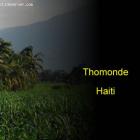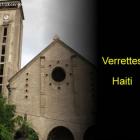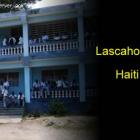ADVERTISEMENT
Island - Haiti Observer Blog
Island, Haiti Observer Blog. Read the following articles about Island
La Gonave Government in Talks to Develop Island for Tourist Trade
Gonâve Island lies on the Caribbean Sea, in the Gulf of Gonâve, to the west and northwest of Port-au-Prince. It is in the La Gonâve Arrondissement, part of Ouest Department. Because the island's topography is composed mainly of limestone, it lacks sufficient vegetation, and low levels of annual rainfall bring on water shortages. La Gonâve Arrondissement is comprised of two districts, Anse-à-Galets and Pointe-à-Raquette. It has a large population of 80,000 inhabitants.
Gonâve's biggest challenge is the scarceness of its water supply. In 2005, a crisis arose when the island experienced a severe drought, bringing many aid agencies to its rescue, sealing springs and erecting rainwater tanks. They have also installed an island-wide water-transport system and dug wells to deliver water to the drought-stricken islanders. A consortium of government, non-government and non-profit organizations, churches, and other aid organizations have established the Water Platform. This body coordinates the efforts of all agencies working on Gonâve to further their work. Within two years of the drought crisis, 25 wells had been dug and more were planned.
L'Ile de la Tortue or Tortuga Island in Haiti
To speak of Tortuga in Haiti, is to conjure up the swashbuckling remnants of the piratical past of the Caribbean, as its representation in literature and the modern entertainment media casts it, almost always, in that quixotically classic light. But Tortuga is more than just pirate stories, more than just a little island off the north coast of Haiti.
Named by Columbus, who, upon happening on the isle in 1492, forming out of the mist of the morning, likened its shape to that of a turtle, it was initially settled by colonists from Spain, but, first made a colony of Santo Domingo by the French. More people would eventually come, as, in the first quarter of the 1600's, additional French settlers, along with some English ones, would travel there. These new residents would, however, face an attack four years later by Don Fadrique de Toledo, who would see to their expulsion before fortifying the island.
Abaka Bay, Ile-a-Vache, ranked 57th most beautiful beach in the world
Noted around the world as a top media enterprise, CNN recently published the results of its 'Most Beautiful Beach in the World' survey. Its May 28th edition showed the results of the online survey CNN opened to the public, which asked everyone from the everyday reader to literal beach and travel aficionados to rate the world's 100 most beautiful beaches.
Putting the words of Haiti's Tourism Minister, Stephanie B. Villendrouin in a prophetic light, the survey ranked Abaka Bay, Ile-à-Vache's Indian name, as 57th on its beautiful world beaches list. This is undoubtedly good press for the country, and the Tourism Ministry is already making use of the accolade.
The Plan for the Development of Ile a Vache Presented to the Public
The Haitian Government has unveiled its plan for the development of the beautiful island of Ile a Vache. As part of the overall development of tourism in Haiti, the Ministry of Tourism has proposed to transform this island located just south of the city of Les Cayes into a destination for adventure, romance and wellness.
A presentation of Ile a Vache by La Bonne Nouvelle:
Main focus of the plan will be to develop eco-tourism-style development, highlighting areas like cultural heritage, agro-tourism and history. The project is divided in many phases with the first phase to develop bungalows and villas in the region of Anse Dufour located near the village of Madame Bernard.
Ile a Vache a Lovers' Paradise
Lying off the south-western end of Haiti, Ile a Vache is the tiniest island of the mainland. Administered under the Sud Department, it takes up 20 square miles of land acreage, a very green island with plenty of swamp areas, containing 10,000-15,000 occupants. Île à Vache is said to be the most scenic place in the entire Caribbean region. Two resorts on the island attract the tourist trade: Abaka Bay and Port Morgan.
The history of the island began with the Spanish conquest, whose settlers named it Isla Vaca. Two hundred years later, France won possession of Hispaniola's western half, Haiti, and Isla Vaca became Ile a Vache.
The Cayemites, Two of Haiti's Smallest Islands
The Caymites are two tiny islands placed just above the southwest coastline of Haiti, a peninsula that juts into the Gulf of Gonave. They are part of Grand-Anse Department, whose biggest metropolitan area is Anse a Macon.
The larger island, Grande Cayemite, sits east of Petite Caymite, both encompassing a total of 17 square miles. A miniscule population of 5,000 inhabitants lives on the islands, their nearest neighbor, Jérémie, lying 22 miles west.
Grand Cayemite and Petite Caymite share many features with other small coastal villages on the Haitian mainland: a subtropical climate and dazzling white-sand beaches that sift through your fingers like sugar. Both Grand and Petite Caymite's topography is made up of lush green vegetation and magnificent rock formations that have endured over the ages.
Who Ownes Navassa Island? - La Navase in Haiti
Navassa, an uninhabited island in the Caribbean Sea, is part of mainland Haiti. Between two- and three-square miles, it sits approximately 100 miles from Guantanamo Detention Center.
Founded in 1504 by sailors, its status during the next 300 years is mostly unclear. But between its founding and U.S. acquisition of the island, marine forces occupied it until it was turned over to the U.S. in the 1850s. For four decades, the U.S. mined the island for the phosphate, guano. Foreign and domestic conflicts brought mining to a halt by the end of the century.
The completion of the Panama Canal in the early 1900s raised Navassa's profile again when a lighthouse was constructed on the island. But in 1996, Navassa became abandoned when its lighthouse operations ceased.
Our objective is to share with you news and information about Haiti and the people of Haiti. Traditions, habits and the way we were or grew are alive in this site. We highly recommend that you Subscribe to our Newsletter and also share with us some of the things that are memorable and made us unique people.

 Thomonde, Haiti
Thomonde, Haiti  Verrettes, Haiti
Verrettes, Haiti  Lascahobas, Haiti
Lascahobas, Haiti  Haiti tech Summit
Haiti tech Summit  Informative Marketing and Advertising in the Haitian Community
Informative Marketing and Advertising in the Haitian Community